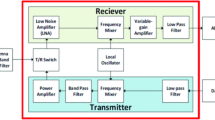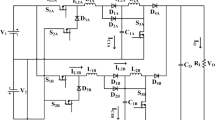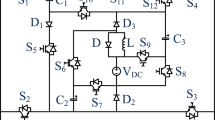Abstract
In this paper, two three-opamp-based active RC biquad structures based on generalized impedance converters (GIC) due to Mikhael–Bhattacharyya and Padukone–Mulawka–Ghausi are re-visited and their equivalence is pointed out. Next, a new two-opamp GIC-based biquad topology derived from them is investigated. The various configurations which can be derived from the proposed biquad topology to realize (a) tuneable pole-frequency (ωp) and constant bandwidth (ωp/Qp) or (b) constant pole frequency with tuneable pole-Q (Qp) are investigated. The effect of opamp finite bandwidth product B as well passive and active sensitivities are presented together with simulation results.











Similar content being viewed by others
Data Availability
Data sharing is not applicable to this article as no datasets were generated or analyzed during the current study, and detailed circuit simulation results are given in the manuscript.
Code Availability
There is no code associated with this work.
References
P.V. Ananda Mohan, VLSI Analog Filters: Active RC, OTA-C, and SC (Modeling and Simulation in Science, Engineering and Technology), Kindle. (Birkhauser, London, 2013)
P.V. Ananda Mohan, Analysis of GIC-based frequency-dependent negative resistance-based filters. Circuits Syst. Signal Process. 42, 2433–2451 (2022)
A. Antoniou, Realization of gyrators using operational amplifiers and their use in RC-active network synthesis. Proc. IEE 116, 1838–1850 (1969)
A. Antoniou, Bandpass transformation and realization using frequency-dependent negative-resistance elements. IEEE Trans. Circuit Theory 18, 297–299 (1971)
P.B. Aronhime, Effects of finite gain-bandwidth product on three recently proposed quadratic networks. IEEE Trans. Circuits Syst. 24, 657–660 (1977)
L.T. Bruton, Frequency selectivity using positive impedance converter-type networks. Proc. IEEE 56, 1378–1379 (1968)
L.T. Bruton, Network transfer functions using the concept of frequency dependent negative resistance. IEEE Trans. Circuit Theory 16, 406–408 (1969)
L.T. Bruton, Non-ideal performance of two-amplifier positive impedance converters. IEEE Trans. Circuit Theory 17, 541–549 (1970)
L.T. Bruton, J.T. Lim, High-frequency comparison of GIC-simulated inductance circuits. Int. J. Circuit Theory Appl. 2, 401–404 (1974)
L.T. Bruton, Multiple-amplifier RC-active filter design with emphasis on GIC realizations. IEEE Trans. Circuits Syst. 25, 830–845 (1978)
C.F. Chiou, R. Schaumann, Performance of GIC-derived active RC biquads with variable gain. Proc. IEE Part G (Electron. Circuits Syst.) 128, 46–52 (1981)
N. Fliege, A new class of second-order RC-active filters with two operational amplifiers. Nachr. Ztg. 26, 279–282 (1973)
N.J. Fleige, Multiple amplifier biquads, chapter 13, in Passive, Active, and Digital Filters, 2nd edn., ed. by W.K. Chen (CRC Press, Boca Raton, 2009). https://doi.org/10.1201/9781315219141
M.S. Ghausi, Analog active filters. IEEE Trans. Circuits Syst. 31, 13–31 (1984). https://doi.org/10.1109/TCS.1984.1085416
M. Hasler, Sensitivity comparison of three GIC band-pass filters. Proc. IEE Part G 128, 158–162 (1981)
A.M. Hassanein, L.A. Said, A.H. Madian, A.G. Radwan, A.M. Soliman, Active and passive sensitivity analysis for the second-order active RC filter families using operational amplifier: a review. Analog Integr. Circuits Signal Process. 113, 257–286 (2022). https://doi.org/10.1007/s10470-022-02079-y
A.M. Hassanein, A.H. Madian, A.G.G. Radwan, L.A. Said, On the design flow of the fractional-order analog filters between FPAA implementation and circuit realization. IEEE Access 11, 29199–29214 (2023). https://doi.org/10.1109/ACCESS.2023.3260093
A. Heszberger, E. Simonyi, Comments on “practical design for insensitive RC-active filters". IEEE Trans. Circuits Syst. 23, 326–327 (1976)
K. Kim, S.-C. Liu, Continuous-time analog filters for audio edge intelligence: review on circuit designs [feature]. IEEE Circuits Syst. Mag. 23(2), 29–48 (2023). https://doi.org/10.1109/MCAS.2023.3267893
K. Martin, A.S. Sedra, Optimum design of active filters using the generalized immittance converter. IEEE Trans. Circuits Syst. 24, 495–503 (1977)
W.B. Mikhael, B.B. Bhattacharyya, A practical design for insensitive RC-filters. IEEE Trans. Circuits Syst. 22, 407–425 (1975)
I.T.M. Mishonov, I.M. Dimitrova, N.S. Serafimov, E.G. Petkov, A.M. Varonov, Q-factor of the resonators with frequency dependent negative resistor. IEEE Trans. Circuits Syst. II Express Briefs 29, 946–950 (2022)
G.S. Moschytz, Linear Integrated Networks: Design (Van Nostrand-Reinhold, New York, 1975)
P.R. Padukone, J. Mulawka, M.S. Ghausi, An active biquadratic section with reduced sensitivity to operational amplifier imperfections. J. Frankl. Inst. 310, 27–40 (1980)
K. Ramakrishna, L.T. Bruton, Noise minimization in RC-active filters using generalized impedance converters. Int. J. Circuit Theory Appl. 6, 135–145 (1978)
K. Ramakrishna, K. Rajgopal, On the design of RC-active high-pass filters using 2-OA GIC. Can. Electr. Eng. J. 10, 69–75 (1985)
R. Raut, M.N.S. Swamy, Modern Analog Filter Analysis and Design: A Practical Approach, 1st edn. (Wiley, Hoboken, 2011)
R. Schauman, M.S. Ghausi, K.R. Laker, Design of Analog Filters—Passive, Active RC and Switched Capacitor (Prentice-Hall, Englewood Cliffs, 1990)
A.S. Sedra, P.O. Brackett, Filter Theory and Design: Active and Passive (Matrix Publishers, New Delhi, 1978)
Funding
No funding was available for this work.
Author information
Authors and Affiliations
Contributions
Conceptualization, methodology, analysis, investigation, writing, editing.
Corresponding author
Ethics declarations
Conflict of interest
There is no conflict of interest from the authors.
Ethics Approval
Not applicable.
Consent to Participate
There is only one author.
Consent for Publication
The authors consent to participate of this publication.
Additional information
Publisher's Note
Springer Nature remains neutral with regard to jurisdictional claims in published maps and institutional affiliations.
Appendix A
Appendix A
The equations describing MB and PMG biquad taking into account finite Gain bandwidth products of the opamps with frequency-dependent gain modeled as \(A_{i} \left( s \right) = - \frac{{B_{i} }}{s}\) are as follows:
MB biquad:
PMG biquad:
Rights and permissions
Springer Nature or its licensor (e.g. a society or other partner) holds exclusive rights to this article under a publishing agreement with the author(s) or other rightsholder(s); author self-archiving of the accepted manuscript version of this article is solely governed by the terms of such publishing agreement and applicable law.
About this article
Cite this article
Ananda Mohan, P.V. New Generalized Impedance Converter (GIC)-Based Two-Opamp Active RC Biquads. Circuits Syst Signal Process 43, 1366–1390 (2024). https://doi.org/10.1007/s00034-023-02548-3
Received:
Revised:
Accepted:
Published:
Issue Date:
DOI: https://doi.org/10.1007/s00034-023-02548-3




